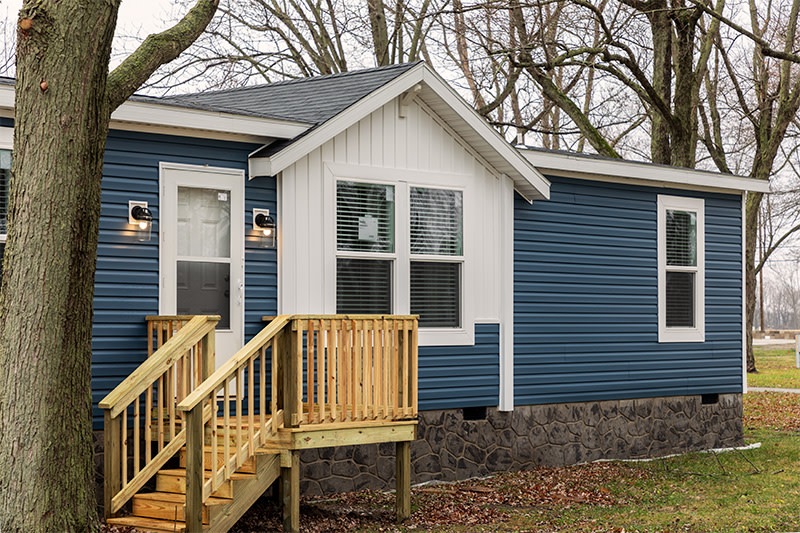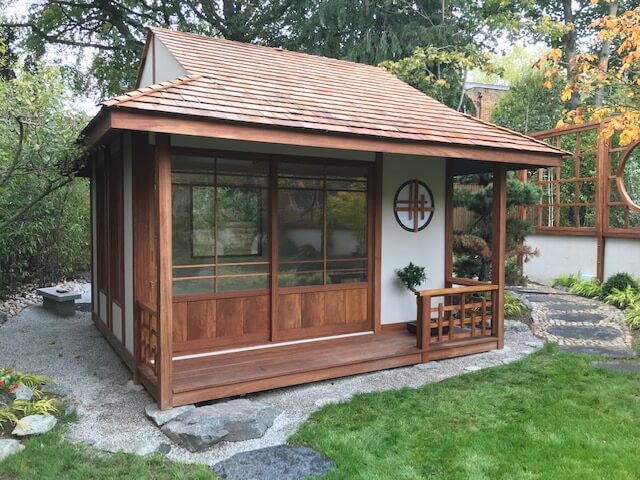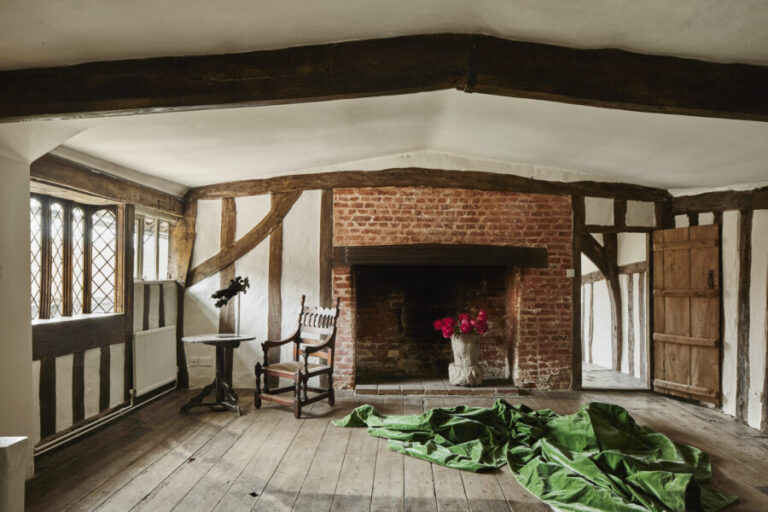What can you use for skirting around a mobile home?
If you own a mobile home, you know that it’s important to maintain and protect it from weather and pests. One area that needs attention is the skirting around the bottom of the mobile home. Skirting is essential to protect the underside of the mobile home, as well as to create a finished look. Skirting can also help to insulate your mobile home and prevent drafts, which can improve your energy efficiency. In this article, we’ll explore some of the different options available for skirting around a mobile home.
1. Concrete Skirting
One of the mobile home skirting ideas is concrete. Concrete skirting can provide a durable and long-lasting solution for your mobile home. Concrete skirting is typically made from precast concrete panels that are designed to fit around the bottom of your mobile home. The panels are then installed with brackets or anchors to keep them in place.
Concrete skirting can provide excellent protection against pests and weather, and it can also help to insulate your mobile home. However, concrete skirting can be more expensive than other options, and it can also be difficult to install. Additionally, if you live in an area with freezing temperatures, you’ll need to make sure that your concrete skirting is properly insulated to prevent cracking.
2. Vinyl Skirting
Another popular option for skirting around a mobile home is vinyl. Vinyl skirting is made from durable PVC material, and it comes in a variety of colors and styles to match your home’s exterior. Vinyl skirting can be easy to install, and it’s relatively inexpensive compared to other options.
Vinyl skirting can provide good protection against pests and weather, and it can also help to insulate your mobile home. However, vinyl skirting can be prone to cracking and fading over time, especially if it’s exposed to sunlight for long periods. Additionally, vinyl skirting may not provide as much durability as other options.
3. Metal Skirting
Metal skirting is another mobile home skirting idea. Metal skirting is typically made from aluminum or steel, and it can provide excellent protection against pests and weather. Metal skirting can also help to insulate your mobile home and prevent drafts.
Metal skirting can be more expensive than other options, but it can also be more durable and long-lasting. Additionally, metal skirting can be easy to install, and it can come in a variety of colors and styles to match your home’s exterior. However, metal skirting may not be as effective at insulating your mobile home as other options, and it can be prone to dents and other damage.
4. Brick Skirting
If you’re looking for a high-end option for skirting around your mobile home, brick skirting may be the solution. Brick skirting is made from real brick, and it can provide excellent protection against pests and weather. Brick skirting can also add a beautiful finished look to your mobile home.
However, brick skirting can be one of the most expensive options for skirting around a mobile home. Additionally, brick skirting can be difficult to install, and it may require professional help. Finally, brick skirting may not provide as much insulation as other options.
5. Wood Skirting
Finally, wood skirting is another option for skirting around a mobile home. Wood skirting can provide a rustic look to your mobile home, and it can be relatively inexpensive compared to other options. Additionally, wood skirting can be easy to install, especially if you’re handy with tools.
However, wood skirting may not provide as much protection against pests and weather as other options, and it can be prone to rot and decay over time.
6. Composite Skirting
Composite skirting is another option for skirting around a mobile home. This type of skirting is made from a combination of wood fibers and plastic, which creates a durable and weather-resistant material. Composite skirting can be a great choice for those who want the look of wood without maintenance.
Composite skirting is relatively easy to install, and it comes in a variety of colors and styles to match your home’s exterior. Additionally, composite skirting is resistant to pests and weather, and it can provide good insulation for your mobile home. However, composite skirting can be more expensive than other options, and it may not be as durable as some other materials.
7. Stone Skirting
For those who want a high-end and luxurious look for their mobile home, stone skirting is an option. Stone skirting is made from natural stone, and it can add a beautiful and elegant finish to your mobile home. Stone skirting can also provide excellent protection against pests and weather.
However, stone skirting is one of the most expensive options for skirting around a mobile home. Additionally, stone skirting can be difficult to install, and it may require professional help. Finally, stone skirting may not provide as much insulation as other options, and it can be prone to cracking and other damage over time.
Factors to Consider
When choosing the right type of skirting for your mobile home, there are several factors to consider. These include:
- Budget: How much are you willing to spend on skirting for your mobile home? Different materials come at different price points, and some options may be more expensive than others.
- Durability: How long do you want your skirting to last? Some materials, such as concrete and metal, are more durable than others, such as vinyl and wood.
- Ease of installation: Do you plan to install the skirting yourself, or will you need professional help? Some materials, such as wood and vinyl, can be easier to install than others, such as brick and stone.
- Insulation: Do you want your skirting to help insulate your mobile home and prevent drafts? Some materials, such as metal and brick, can provide better insulation than others, such as vinyl and wood.
- Aesthetics: Do you want your skirting to match the look of your mobile home’s exterior? Different materials come in different colors and styles, so you’ll want to choose one that complements your home.
What are the benefits of skirting for my manufactured home?
Skirting is an important component of manufactured homes that provides several benefits, including:
1. Protection from the Elements
Skirting provides a barrier between the bottom of your home and the ground, protecting it from moisture, wind, and other environmental factors. This protection can help prevent damage to your home and improve its durability.
2. Enhanced Insulation
Skirting can also help improve the insulation of your home by reducing airflow underneath the home. This can help keep your home cooler in the summer and warmer in the winter, reducing your energy bills and increasing your comfort.
3. Improved Appearance
Skirting can improve the appearance of your manufactured home by hiding the underside and creating a finished look. Skirting comes in a variety of materials, colors, and styles, so you can choose one that complements the design of your home and enhances its curb appeal.
4. Pest Control
Skirting can also help keep pests such as rodents, snakes, and insects from getting under your home. This can reduce the risk of damage to your home’s insulation, wiring, and plumbing, and can help keep your family safe from potential health hazards associated with pest infestations.
5. Compliance with Local Regulations
Many local jurisdictions require manufactured homes to have skirting as part of their building code regulations. Installing skirting on your home can ensure that you are in compliance with these regulations, avoiding potential fines and penalties.
To use skirting, do I need a certain kind of foundation?
The type of foundation you have for your home can affect the type of skirting you can use. Generally, there are two main types of foundations for manufactured homes: pier and beam and concrete slab.
1. Pier and Beam Foundation
Pier and beam foundations consist of a series of concrete piers or blocks that support the weight of the home. This type of foundation allows for more airflow under the home and is typically used in areas with high moisture levels or unstable soil. For homes with a pier and beam foundation, skirting can be installed using a track or channel system that attaches the skirting panels to the perimeter of the home. This system allows for easy installation and removal of the skirting, making it easier to perform maintenance or repairs underneath the home.
2. Concrete Slab Foundation
Concrete slab foundations consist of a solid concrete slab that the home is placed on. This type of foundation provides a stable and secure base for the home and is typically used in areas with stable soil and low moisture levels. For homes with a concrete slab foundation, skirting can be attached directly to the slab using anchors or adhesive. This method of installation provides a more permanent attachment and can be more difficult to remove for maintenance or repairs.
It is important to note that each state and local jurisdiction has its own specific building codes and regulations regarding foundations and skirting for manufactured homes. It is important to consult with a licensed contractor or local building authority to determine the appropriate foundation and skirting requirements for your area.
Can you install the underpinning yourself?
While it is possible to install underpinning or skirting yourself, it is important to note that it can be a challenging and time-consuming project, particularly if you are not experienced in home improvement or construction. In addition, if the skirting is not installed correctly, it can cause damage to your home and potentially void any warranties you have on your manufactured home.
If you do decide to install underpinning yourself, there are a few things to keep in mind:
- Choose the Right Material: There are many different types of skirting materials available, including vinyl, concrete, and wood. Each material has its own advantages and disadvantages, so it is important to choose the right one for your needs and budget.
- Properly Prepare the Area: Before installing the skirting, it is important to properly prepare the area around your home. This may involve grading the ground, removing debris, and installing any necessary drainage systems.
- Follow the Manufacturer’s Instructions: Each skirting material will have its own installation instructions. It is important to carefully read and follow these instructions to ensure that the skirting is installed correctly.
- Use the Right Tools: Depending on the type of skirting you are installing, you may need a variety of tools, including a saw, drill, level, and hammer. It is important to have the right tools for the job to ensure that the skirting is installed correctly.
- Consider Hiring a Professional: If you are not comfortable with installing underpinning or skirting yourself, or if you have a complicated foundation or terrain around your home, it may be a good idea to hire a professional to handle the installation for you. This can ensure that the skirting is installed correctly and that your home is protected from the elements and pests.
Conclusion
Skirting around a mobile home is an important aspect of home maintenance and protection. There are several different mobile home skirting ideas are available, each with its own pros and cons. Whether you choose concrete, vinyl, metal, brick, wood, composite, or stone skirting, it’s important to consider factors such as budget, durability, ease of installation, insulation, and aesthetics when making your decision. By choosing the right type of skirting, you can protect your mobile home and give it a finished look that enhances its value and curb appeal.



